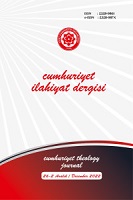Tümevarım Metodu Açısından en-Naḥvu’l-vâḍıḥ ve el-Ḳavâ‘idu’l-‘arabiyyetu’l-muyessere Adlı Arapça Dilbilgisi Kitaplarının İncelenmesi: Nitel Bir Araştırma
An Examination of the Arabic Grammar Works Named al-Naḥw al-wāḍiḥ and al-Qawā’id al-‘arabiyya al-muyassara in Terms of the Inductive Method: A Qualitative Research
Author(s): Mesut KöksoySubject(s): Language acquisition, Educational Psychology, Sociology of Education
Published by: Cumhuriyet Üniversitesi İlahyat Fakültesi
Keywords: Arabic Grammar; Inductive; Method; al-Naḥw al-Wāḍiḥ; al-Qawā’id al-‘Arabiyya al-Muyassara;
Summary/Abstract: In the modern era, a great variety of methods have been developed in grammar teaching. Among these, the induction (istiqrā'), which is applied as an alternative to the traditional approach called deduction (qiyās), is one of the main methods adopted in the modern period. At the beginning of the study, information about inductive and deductive methods and the differences between these two was given. When Arabic grammar teaching in Turkey is evaluated in terms of methodological approach, it can be seen that there have been discussions and uncertainties about traditional and modern techniques. Then, the grammar teaching methods of the books were examined- namely, al-Naḥw al-wāḍiḥ and al-Qawāʻid al-ʻarabiyya al-muyassara, which were prepared by following the inductive method and have been used in Turkey for many years. Both works provide explanatory information about the inductive method they followed in the preface. Both works firstly give examples in accordance with the inductive method, then analyze the examples, induce the rule and finally summarise the rule. Both works contain various and a large number of exercises. In the continuation of the study qualitative research was conducted using the semi-structured interview technique with 16 randomly selected students who took the course with the work called al-Qawāʻid al-ʻarabiyya al-muyassara at Selçuk University in addition to a grammar book prepared by following the deductive method to learn the approaches of the students to the grammar teaching methods. When the students were asked to choose one of the deductive and inductive methods, it was seen that 5 out of 8 students in both groups chose the deductive method, while 3 chose the inductive method. The students who preferred the deductive method in both groups stated that explaining the rule and then giving examples is more useful. On the other hand, those who do not prefer the deductive method, especially among the students who have just started their education in Arabic, stated that explaining the rule in detail at first causes confusion and creates anxiety. The students who preferred the inductive method in both groups stated that analyzing the rule through examples helped them to understand the rule more easily and to realize the points that they should pay attention to. On the other hand, students who do not prefer the inductive method stated that analyzing the examples without knowing the rule makes it difficult for them to understand the rule. The approach of the students to the detailed or summarised explanation of the rule is directly proportional to their method preferences. While the students who prefer the deductive method find the detailed explanation of the rule more useful, the students who prefer the inductive method find the summarised explanation of the rule more beneficial. On the other hand, it is seen that students' approaches to the redundancy of terms in grammar teaching may differ with their method preferences. As expected, students who choose the inductive method find it more practical to use less terms. However, contrary to expectations, students who have been studying Arabic for a long time and prefer the deductive method find it more useful to use less terms. All of the students in both groups stated that giving a lot of exercises for practicing is very helpful in comprehending the rules and putting them into practice. Regarding the work named alQawāʻid al-ʻarabiyya al-muyassara, the presenting of grammar through texts, the clarity of texts and topics, the abundance of exercises and examples and the summary of the rules are the points that the students found favourable. Presenting the texts without learning the rule, having too much Arabic content, not having explanations in Turkish and not having a variety of text content are the points that the students found unfavourable. It was concluded that it would be more effective to follow a mixed method in which the positive aspects are considered instead of comparing both methods in terms of usefulness as in the following order: Briefly explaining the rules in as few terms as possible, in plain language and in general terms. Giving non-literary examples related to modern life by grouping them according to the rule. Analyzing the rule through one of the examples in each group. Giving detailed information and exceptional uses related to the rule in footnotes. Giving place to various and a large number of exercises, following a sequence from easy to difficult. Finally giving the summarised rules again with different examples.
Journal: Cumhuriyet İlahiyat Dergisi
- Issue Year: 26/2022
- Issue No: 2
- Page Range: 841-861
- Page Count: 21
- Language: Turkish

